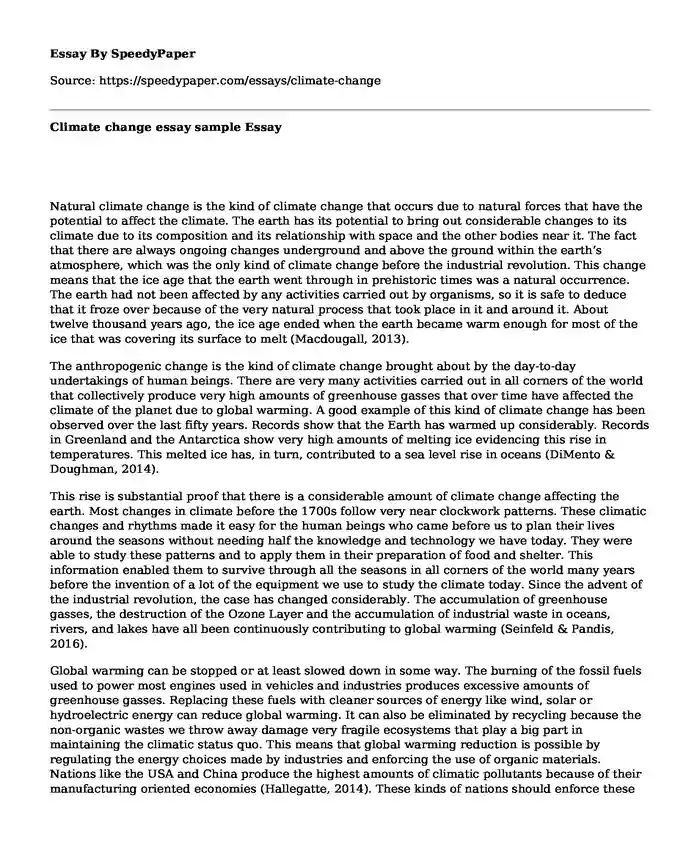Natural climate change is the kind of climate change that occurs due to natural forces that have the potential to affect the climate. The earth has its potential to bring out considerable changes to its climate due to its composition and its relationship with space and the other bodies near it. The fact that there are always ongoing changes underground and above the ground within the earth’s atmosphere, which was the only kind of climate change before the industrial revolution. This change means that the ice age that the earth went through in prehistoric times was a natural occurrence. The earth had not been affected by any activities carried out by organisms, so it is safe to deduce that it froze over because of the very natural process that took place in it and around it. About twelve thousand years ago, the ice age ended when the earth became warm enough for most of the ice that was covering its surface to melt (Macdougall, 2013).
The anthropogenic change is the kind of climate change brought about by the day-to-day undertakings of human beings. There are very many activities carried out in all corners of the world that collectively produce very high amounts of greenhouse gasses that over time have affected the climate of the planet due to global warming. A good example of this kind of climate change has been observed over the last fifty years. Records show that the Earth has warmed up considerably. Records in Greenland and the Antarctica show very high amounts of melting ice evidencing this rise in temperatures. This melted ice has, in turn, contributed to a sea level rise in oceans (DiMento & Doughman, 2014).
This rise is substantial proof that there is a considerable amount of climate change affecting the earth. Most changes in climate before the 1700s follow very near clockwork patterns. These climatic changes and rhythms made it easy for the human beings who came before us to plan their lives around the seasons without needing half the knowledge and technology we have today. They were able to study these patterns and to apply them in their preparation of food and shelter. This information enabled them to survive through all the seasons in all corners of the world many years before the invention of a lot of the equipment we use to study the climate today. Since the advent of the industrial revolution, the case has changed considerably. The accumulation of greenhouse gasses, the destruction of the Ozone Layer and the accumulation of industrial waste in oceans, rivers, and lakes have all been continuously contributing to global warming (Seinfeld & Pandis, 2016).
Global warming can be stopped or at least slowed down in some way. The burning of the fossil fuels used to power most engines used in vehicles and industries produces excessive amounts of greenhouse gasses. Replacing these fuels with cleaner sources of energy like wind, solar or hydroelectric energy can reduce global warming. It can also be eliminated by recycling because the non-organic wastes we throw away damage very fragile ecosystems that play a big part in maintaining the climatic status quo. This means that global warming reduction is possible by regulating the energy choices made by industries and enforcing the use of organic materials. Nations like the USA and China produce the highest amounts of climatic pollutants because of their manufacturing oriented economies (Hallegatte, 2014). These kinds of nations should enforce these policies as soon as possible if we are going to beat climate change before it destroys life, as we know it.
References
DiMento, J. F., & Doughman, P. (2014). Climate change: What it means for us, our children, and our grandchildren. MIT Press.
Hallegatte, S. (2014). Natural disasters and climate change: An economic perspective. Cham: Springer
Macdougall, J. D. (2013). Frozen earth: The once and future story of ice ages. Berkeley: University of California Press.
Seinfeld, J. H., & Pandis, S. N. (2016). Atmospheric chemistry and physics: from air pollution to climate change. John Wiley & Sons.
Cite this page
Climate change essay sample. (2018, Jan 19). Retrieved from https://speedypaper.net/essays/climate-change
Request Removal
If you are the original author of this essay and no longer wish to have it published on the SpeedyPaper website, please click below to request its removal:
- Essay Example on Inspirational Ways to Write More
- Forgiveness Essay Example
- Capitalism, North American Economy 1880-1950, Mexican Revolution - Free Essay in Economic History
- Andreas Ekstrom: The Moral Bias
- Definition Essay Example - Help and Bridge Terms
- Free Essay on Coaching and Counselling
- Free Essay Example. Church and State Concept
Popular categories





